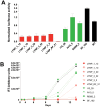Identification of a cluster of HIV-1 controllers infected with low replicating viruses
- PMID: 24204910
- PMCID: PMC3813686
- DOI: 10.1371/journal.pone.0077663
Identification of a cluster of HIV-1 controllers infected with low replicating viruses
Abstract
Long term non-progressor patients (LTNPs) are characterized by the natural control of HIV-1 infection. This control is related to host genetic, immunological and virological factors. In this work, phylogenetic analysis of the proviral nucleotide sequences in env gene from a Spanish HIV-1 LTNPs cohort identified a cluster of 6 HIV-1 controllers infected with closely-related viruses. The patients of the cluster showed common clinical and epidemiological features: drug user practices, infection in the same city (Madrid, Spain) and at the same time (late 70's-early 80's). All cluster patients displayed distinct host alleles associated with HIV control. Analysis of the virus envelope nucleotide sequences showed ancestral characteristic, lack of evolution and presence of rare amino-acids. Biological characterization of recombinant viruses with the envelope proteins from the cluster viruses showed very low replicative capacity in TZMbl and U87-CD4/CCR5 cells. The lack of clinical progression in the viral cluster patients with distinct combinations of protective host genotypes, but infected by low replicating viruses, indicate the important role of the virus in the non-progressor phenotype in these patients.
Conflict of interest statement
Figures







References
-
- Schrager LK, Young JM, Fowler MG, Mathieson BJ, Vermund SH (1994) Long-term survivors of HIV-1 infection: definitions and research challenges. AIDS 8 (suppl. 1)S95–S108. - PubMed
-
- Lambotte O, Boufassa F, Madec Y, Nguyen A, Goujard C, et al. (2005) HIV controllers: a homogeneous group of HIV-1-infected patients with spontaneous control of viral replication. Clin Infect Dis 41: 1053–1056. - PubMed
Publication types
MeSH terms
Substances
LinkOut - more resources
Full Text Sources
Other Literature Sources
Medical
Research Materials

